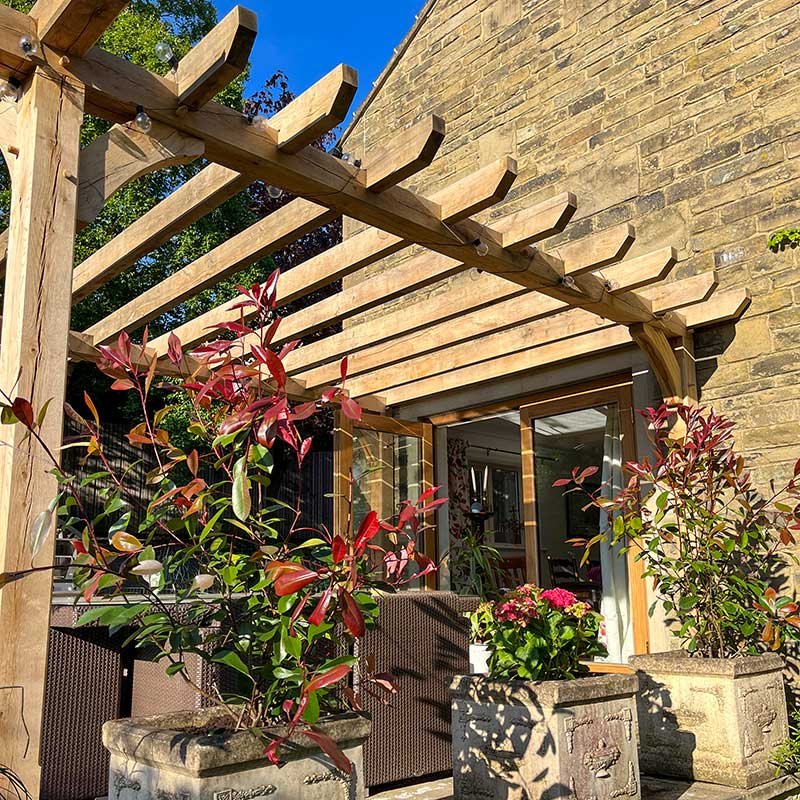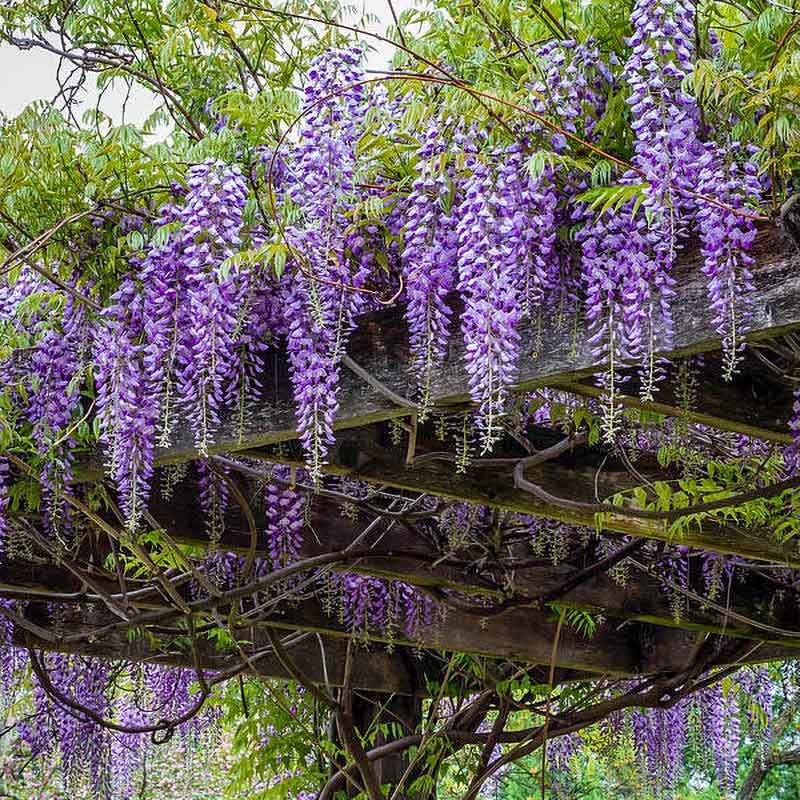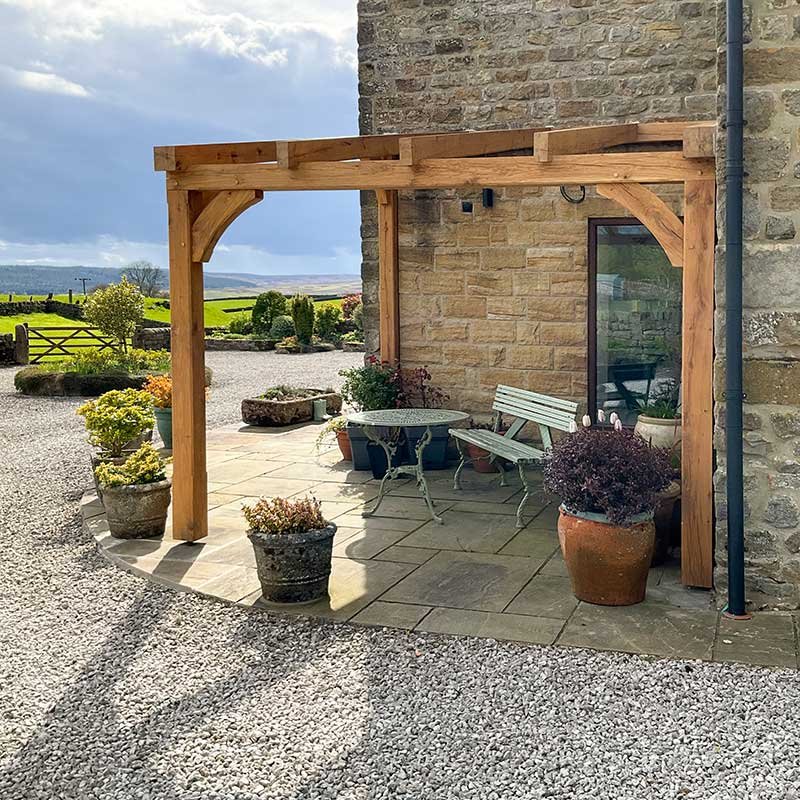
oakbydesign
01423 593 794



An oak pergola draped in lush greenery can be a living tapestry, weaving together beauty and utility in an outdoor space. Transforming a simple pergola into a verdant retreat involves selecting the right climbing plants and balancing fast-growing varieties with seasonal blooms. With careful planning and maintenance, this transformation can provide year-round visual interest and shaded comfort. However, the choice of potted plants and the timing of seasonal options play a vital role in achieving the desired aesthetic. How does one navigate these choices to create a thriving and picturesque pergola sanctuary?
When selecting the best climbing plants for your pergola, several standout options provide both aesthetic charm and horticultural benefits.
Climbing roses, renowned for their flexible canes and abundant blooms, create a visually striking and fragrant environment.
Climbing hydrangeas offer lush foliage and lace-cap flowers, yet require patient cultivation and regular pruning.
Trumpet vines flourish in full sun, producing vibrant, tubular flowers that attract pollinators.
Wisterias are celebrated for their cascading racemes of purple or white flowers but necessitate stringent pruning to manage their vigorous growth.
Each species presents unique attributes, contributing to a pergola’s transformative potential when chosen with care.
For those enthusiastic to swiftly transform their pergola into a lush green sanctuary, fast-growing climbing plants are a remarkable choice.
Honeysuckle offers rapid growth and a delightful fragrance, with certain species exhibiting growth rates upwards of 12 inches per year.
The vigorous Golden Hops can reach heights of 4-6 meters in a single growing season, providing dense foliage ideal for privacy.
Another excellent option is the Trumpet Vine, known for its exuberant, tubular blooms and robust climbing capabilities.
These species, when supported by sturdy trellises and provided with adequate water and nutrients, can quickly establish a verdant canopy, enhancing both the aesthetic and ecological value of the pergola.


While fast-growing varieties rapidly cloak a pergola in greenery, integrating potted plant choices introduces a dimension of adaptability.
Clematis, with its unique tepals, thrives in sheltered pots and requires minimal pruning. English Ivy, a low-maintenance perennial, spreads quickly and self-clings, making it resilient to adverse weather. Jasmine, known for its fragrant, white corollas, excels in well-drained soil.
Additionally, the Passion Flower, ideal for warm climates, can be repositioned to optimise photoperiodism, showcasing its vibrant tepals.
Utilising potted plants allows for facile repositioning, seasonal adjustments, and tailored aesthetic preferences. This flexibility guarantees the pergola remains visually appealing and adaptable to varying environmental conditions, offering both ornamental and functional versatility.
Selecting plants that thrive in specific seasons can greatly enhance the visual dynamism and biodiversity of a pergola.
During spring, Clematis montana, known for its vigorous growth and profusion of pink or white flowers, can invigorate the structure.
Summer introduces Bougainvillea, flourishing in warm temperatures and providing vibrant magenta bracts.
Autumn is ideal for the Virginia Creeper, which showcases stunning red foliage, adding a dramatic touch.
In winter, the evergreen foliage of Star Jasmine, coupled with its delicate, fragrant flowers, maintains year-round appeal.
By aligning plant selection with seasonal growth patterns, one can guarantee continuous bloom cycles and robust ecological interactions.
Proper seasonal choices foster not only aesthetic continuity but also ecological resilience, maximising the pergola’s horticultural potential.


Guaranteeing the longevity and importance of your pergola’s plant ensemble necessitates a strategic approach to maintenance.
Regular pruning is essential to manage growth and encourage flowering, particularly for vigorous species like wisteria and trumpet vine.
Employing proper irrigation techniques, such as drip systems, guarantees consistent moisture levels, mitigating the risk of root rot and fungal diseases.
The addition of mulching around the base of plants conserves soil moisture and suppresses weed growth.
Keep monitoring for pests, such as aphids and spider mites, and employing integrated pest management strategies maintain plant health.
Undertaking relevant fertilisation, tailored to specific plant needs, supports robust growth and blooming.
Telephone: 01423 593 794
Locksley Park
Blind Lane
Tockwith
YORK YO26 7QJ
Opening Times:
Mon to Fri - 9.00am to 5.00pm
Bank Holidays - Closed
Christmas 2025- TBC
Oak By Design is the trading name of:
Oak By Design Ltd.
Reg Number: 04384416
VAT Number: 664 8012 33